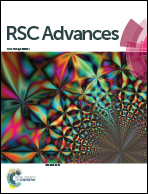Kinetic analysis of a high-affinity antibody/antigen interaction performed by planar waveguide fluorescence immunosensor†
Abstract
Methods based on optical biosensors for the investigation of biomolecular interactions between high-affinity antibodies and antigens has advanced over the last years. In this study, experimental and data analysis protocols were developed to determine the rate and equilibrium constants by using multiplexed planar waveguide fluorescence immunosensor. Four different antibodies were used as models in the test system. Antigen–BSAs were immobilized on the sensor surface, and the binding of specific antibodies labeled with Cy5.5 under certain conditions was measured. Sets of binding curves obtained with different antibody concentrations were analyzed by using the numerical integration of differential rate equations and global fitting applying by the one to one reaction model. As a result, the kinetic rate constants (ka and kd) and affinity (KD) can be determined for each antibody interaction under identical conditions. An indirect competitive immunoassay simulation model is also presented in the paper and shows the relationship between detection response, initial concentration of antibody and affinity constant. By analyzing the results and fitted in the indirect competitive immunoassay model, the optimized concentration of antibody and working ranges for detection can be estimated. Thus, the application of waveguide fluorescence immunosensors for protein interaction analysis is a promising and high throughput tool for obtaining data on the binding behavior between antibodies and antigens, and support the optimization in immunoassay.


 Please wait while we load your content...
Please wait while we load your content...